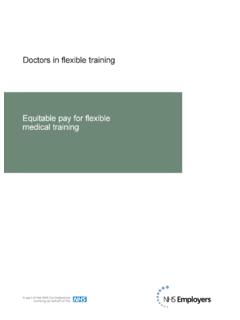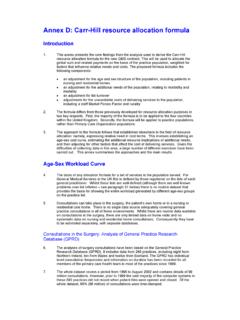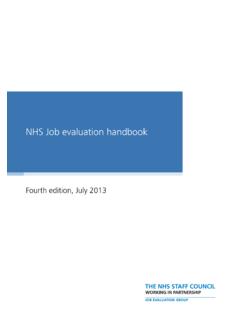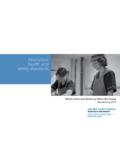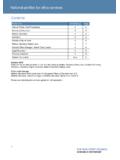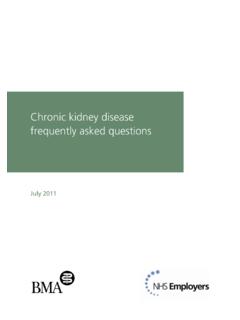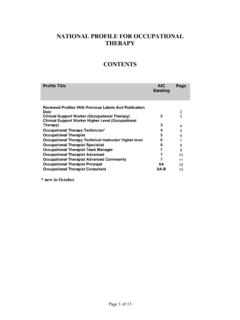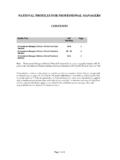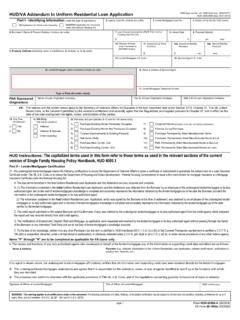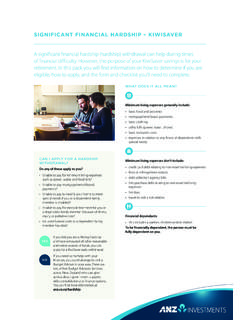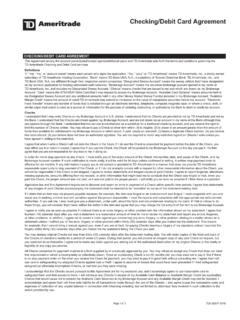Transcription of RETIREMENT GUIDELINES FOR STAFF AND MANAGERS
1 RETIREMENT GUIDELINES FOR. STAFF AND MANAGERS . February 2010. Contents Page No. 1. INTRODUCTION 3. 2. AGE RETIREMENT 3. 3. FLEXIBLE RETIREMENT OPTIONS 4. 4. PROCEDURE 5. 5. RETIREMENT GIFT 6. 6. USEFUL CONTACTS 6. 2. 1. INTRODUCTION. This pack is intended to answer some of the questions STAFF and MANAGERS may have regarding RETIREMENT . The aim is to assist STAFF in dealing with the period prior to a RETIREMENT , whether it's age RETIREMENT , ill health RETIREMENT or early RETIREMENT . Most importantly the Trust wants to make the RETIREMENT process for those who wish to retire as easy and as problem free as possible.
2 There are now around 150,000 current NHS STAFF who are aged over 50 and some 50,000 of these are nurses. The Trust recognises and values the significant contribution of the workforce and the skills and experience that they have amassed over the length of their employment within the NHS. It is for this reason that STAFF considering RETIREMENT should be aware of the many opportunities that exist to stay on in employment with the Trust, or return following RETIREMENT . This is one of the measures taken to fulfil the Trust's aims of tackling vacancies and providing a quality service.
3 Flexibility in the area of RETIREMENT is often not considered because STAFF and MANAGERS believe that this can reduce pension entitlements. In fact this is rarely the case. Included in these GUIDELINES are a number of flexible RETIREMENT options, which you could consider including Winding Down, Stepping Down, Retire and Come Back, Draw Down (for members of the 2008 section of the NHS Pension Scheme only) and Late RETIREMENT . These options will be explained in more depth in the GUIDELINES . 2 AGE RETIREMENT . Trust RETIREMENT Age The Trust does not operate a mandatory RETIREMENT age, therefore, the decision about whether to retire is a matter for each individual employee.
4 NHS Pension RETIREMENT Age & Benefits The minimum pension age is changing for any member who joined the NHS Pension Scheme for the first time on or after 6 April 2006, or who rejoined on or after 6 April 2006. and had previously left before 1 April 2000. 1995 Section Under the 1995 section of the NHS Pension Scheme, normal age RETIREMENT is at age 60. and the minimum pension age is 50, but benefits will be reduced to cover the extra cost of receiving a pension for a longer period., However for the above group of members the minimum pension age will change from 6 April 2010 to age 55.
5 For members who fall into the above category this means that if they wanted to draw voluntary early RETIREMENT pension benefits before 6 April 2010 they are able to do so from age 50 but from 6 April 2010 they must be at least age 55 to access these pension benefits. Members who have transferred into the NHS Pension Scheme as part of a block transfer and who had a minimum pension age of 50 in the sending scheme will retain a minimum pension age of 50. 3. 2008 Section The 2008 section of the NHS Pension Scheme allows normal age RETIREMENT at age 65.
6 Members can opt for voluntary early RETIREMENT from age 55, however, benefits will be reduced to cover the extra cost of receiving a pension for a longer period. Benefits STAFF who are members of the NHS Pension Scheme will receive RETIREMENT benefits, which consist of an annual pension paid for life and a tax-free lump sum. The amount received depends on the individual's pensionable pay, how long they have been a member of the scheme and whether they have worked part time. With effect from 1 April 2008, the maximum membership age is 75 with a membership limit of 45 years.
7 Special Class Status There are people in certain STAFF groups with Special Class Status MHO status - Mental Health Nurses, who were members of the NHS Pension Scheme before 6 March 1995 and who have qualifying service. They can retire with full pension benefits from age 55 although the same conditions with regard to RETIREMENT before age 55 still apply. Special Class Status is no longer granted to new entrants to the Scheme on or after 6 March 1995. Re-entrants to Special Class type employment retain the status in the Scheme if they do not have a break in pensionable scheme membership of 5 years or more.
8 Notice Requirements Where an employee is intending to retire under the provisions of the NHS Pension Scheme, whether taking normal age RETIREMENT or voluntary early RETIREMENT , it is necessary for the member of STAFF to provide 4 months notice (or their contractual notice if this is greater), in writing, of their intention to retire, in order to ensure that the relevant documentation is processed for calculation of final pension figures and to arrange payment. Non-Pension Scheme Members should give their contractual notice. 3 FLEXIBLE RETIREMENT OPTIONS.
9 Option1: Wind Down As an alternative to simply retiring, STAFF may wish to discuss with their manager the possibility of working fewer days in their existing post. Impact on benefits Pensions for part time STAFF are calculated on the whole time equivalent salary, so moving from full time to part time work, rather than retiring, should not reduce the level of pensionable pay for the calculation of pension benefits. However, it will reduce the rate at which members build up future membership. 1995 section Benefits are calculated on the basis of 1/80th of the best of the last three year's pensionable pay for each year of pensionable membership.
10 2008 section Benefits are calculated on the basis of 1/60th of annual average of best three consecutive year's pensionable pay, in last ten years. 4. Option 2: Step Down In some instances STAFF may be considering retiring due to the pressure and responsibilities of your current role. By agreement with Human Resources and the employee's manager, STAFF may be able to step down into a lower graded and therefore lower paid and less demanding post, which will still make use of their skills and experience. Impact on benefits The level of pensionable pay is protected for the calculation of pension benefits for STAFF who are over the minimum RETIREMENT age.
